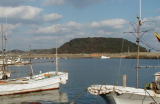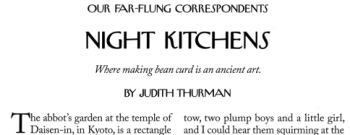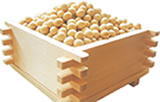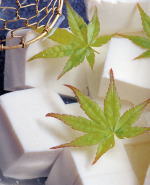(Part of the article)
If you don't speak Japanese, travelling alone in provincial Japan is not
for the timid: the lingua franca is pantomime. I mastered the greetings,
which change according to the time of day, a few adjectives ( though I
got into trouble with oishii―delicious―which may have a lewd connotation is the wrong context); and
I learned to count. So finding the Yoyokaku had been a stroke of luck.
The motherly proprietress, Harumi Okochi, whose husband's family have been
innkeepers in Karatsu for more than a century, is a former English teacher
with a nuanced command of the language, and of the local society and folklore.
Her library overlooks a rock garden and a waterfall, and, after I had bathed
in the ryokan's communal tub and wrapped myself in a blue-and-white yukata, she poured me some tea and we sat reading poetry―paeans to tofu. She
asked me if I knew the "Manyoshu" ("Assembly of Ten Thousand
Leaves"), an anthology of literary treasures collected in the eighth
century. "Some of its earliest verse," she said, "was written
on Kashiwajima, an island you can see from the tower of the castle, and
the fishermen there may have been among the first Japanese to make bean
curd. According to legend, their tofu was so hard that it could break stones.
That is what they still call it: ishiwari―stone breaking―dofu. Though I have lived here all my life, I have never tasted it."
Kashiwajima is a worn, whale-shaped lump of volcanic rock boiling with
greenery. Its love poets were the soldiers of a lonely garrison, watching
the sea for Korean war galleys, thirteen hundred years ago, and pining
for their wives. One afternoon, I hired a launch from a pier near the castle.
It bounced across the swell while I clung to the guardrail with white knuckles.
Mrs. Okochi, who had changed from a kimono into a pair of cotton trousers,
sat primly unperturbed in the cabin, watching for flying fish, and holding
a beautifully wrapped box of sweets from the inn, which she'd thought to
bring as a gift for the chief tofu-maker, Hiromi Takahira, who had agreed
to re-open her workshop for us at an ungodly hour:3 P.M.
The little marina was deserted, though from somewhere nearby we heard the
sounds of karaoke. There wasn't a tea-house or a store in sight, so we
meandered around the waterfront until we found the workshop, in a corrugated
shed on one of the piers. Pampas grass, wild hollyhocks, and thistle were
growing by the front door, and the place, like the island generally, had
a melancholy air. Kashiwajima has always been dependent on the sea, but
in recent times it had lost many of its young people to jobs on the mainland.
The elders who remain, however, are a hardy lot. An uni fisherman with white hair and a deep tan, who squatted in a doorway on
sinewy haunches while mending his nets, was looking for a wife, he told
Mrs. Okochi, eying her hopefully. "You should meet my sister,"
he added, waving down an elderly cyclist laden with buoys and baskets―Kashiwajima's
last female abalone diver. She was pedalling home in a ratty wetsuit and
a faded bonnet, toothless and cheerful, though also a little embarrassed,
she told Mrs. Okochi, to be seen with such a puffy face. That, she explained,
is what happens when you plug your ears and hold your breath long enough
to catch a snap-jawed mollusk clinging to a reef thirty feet down.
At the workshop, Mrs. Takahira, a seventy-one-year-old fisherman's widow
with a round face and a radiant complexion (tofu and hard labor are her
beauty secrets, she said) welcomed us with a deep bow. The windows of the
shed were open, and the sea breeze carried a scent of rain, wildflowers,
and algae. Before her marriage, she told us, she worked on her parents'
farm, growing soybeans, and then she became a nurse in Karatsu. After her
husband died, and her two sons left home, they told her to stop making
tofu for herself―it was too much trouble. But about five years ago she
decided that the island should exert "more of an effort to show the
world that we exist," she said. "In the olden days, we were known
for our ishiwari dofu. People made it for funerals and weddings, and it was eaten in a fish
broth. Now they're too busy. I started thinking that maybe it could be
revived. A few friends said they would help, and the Karatsu town council
gave us some marketing advice. There are sixteen of us, and we take shifts.
Stone-breaking tofu got its name, according to Mrs. Takahira, because one
day an islander walking home dropped her basket an spilled her tofu. "It
didn't crumble, but the stone it fell on did," she said. "You
can believe that or not, but it's very concentrated. We use five times
as many soybeans for the same amount of tofu as other makers do, and organic
Japanese daizu is three times as expensive as American beans, so we don't make much profit.
They passed a law saying you can't use the local ocean water as a nigari anymore―because of the pollution―so we buy evaporated natural sea salt from O-Shima, and that's what makes it so hard. But too much salt turns your tofu bitter, and if you overcook it, it stinks."
The only concession Mrs. Takahira makes to convenience, or age, is to pulverize the soybeans in an electric grinder. Otherwise, her tofu-making is powered entirely by muscle. She presses the okara with wooden rolling pins, then squeezes it like as Old World washer-woman
wringing linen sheets.Each of the molds is compressed for forty minutes
with a twenty-pound weight that she slings about with one hand as if it
were a can of tuna fish. When she turns out the bricks of bean curd, their
surface is crackled, like parched desert clay. Their texture is a bit grainy,
and they offer some faint resistance to a knife. They are thoroughly oishii, though, with an intense soy flavor and the definitive, though unplaceable, sweetness that artisanal tofu seems to share, and which, like the scent of lotus blossoms in a folktale, signals the presence of an unseen divinity.◆ |
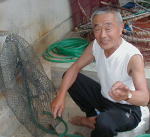
An uni fisherman
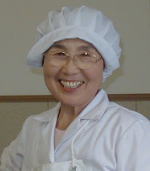
Mrs. Hiromi Takahira
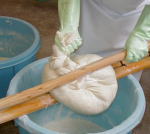
squeeze
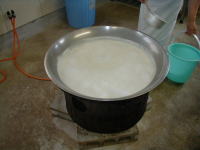
boil
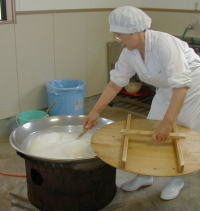
add nigari and stir
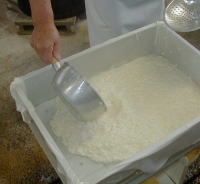
into the mold
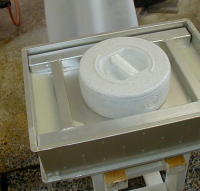
compress and wait
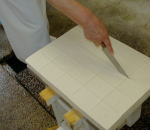
cut into proper size
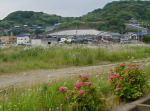
Kashiwajima village
|
